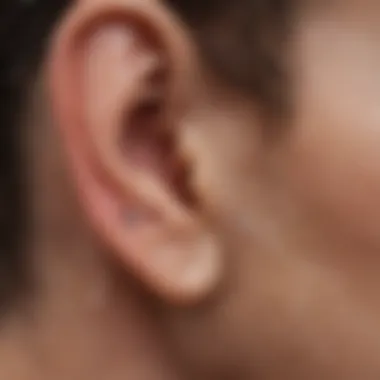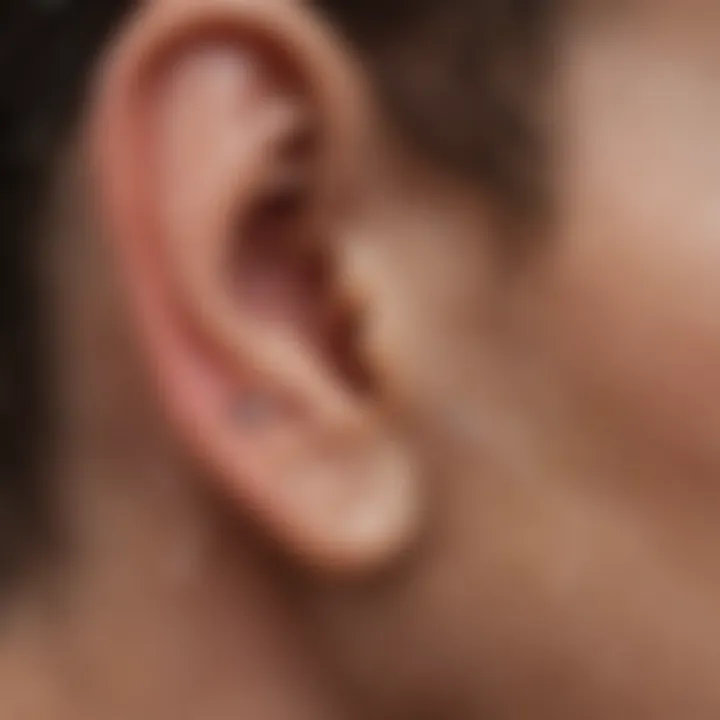Understanding Water in the Ear: Causes and Solutions


Intro
Water in the ear is more than just an annoyance; it's a common experience for many people particularly those who engage in water sports or swimming. When water gets trapped in the ear canal, it can lead to discomfort and, in some cases, more serious issues like infections. Understanding the reasons behind this phenomenon becomes crucial for anyone looking to enjoy their time in the water without the lingering effects of ear problems.
Understanding the mechanics of how water becomes trapped involves not just the physical activity but also the physiological aspects of the human ear. The ear canal is designed to be somewhat self-cleansing, but external factors like swimming style or even earwax can influence its capacity to drain water effectively. If you're a freestyler at the pool or a casual beachgoer, knowing the ins and outs of ear health can change your water experience dramatically.
In this article, we explore various methods to handle and prevent water retention in the ear, addressing common myths surrounding the issue, as well as offering actionable tips for both novice swimmers and seasoned athletes. From diving into preventive measures to understanding the implications of water in the ear, this guide aims to make your aquatic activities both enjoyable and safe. Let's dive in.
Preface to Ear Water Accumulation
Water accumulation in the ear can turn a day of fun into a frustrating experience, especially for those who love the waves and splashes. This phenomenon, while common, isn't just a minor annoyance; it can have significant implications for both casual swimmers and dedicated watersport enthusiasts. Understanding the intricacies of how water gets trapped in the ear helps in managing potential complications, ensuring safety, and enhancing the overall enjoyment of your aquatic adventures.
Definition and Overview
Water in the ear, often referred to as "ear water retention," occurs when water becomes trapped in the ear canal. This can happen during various activities like swimming, diving, or even showering. The ear structure, which includes several parts, can sometimes hold onto water due to the shape of the ear canal or the presence of earwax. The sensation of this water sitting in the ear can lead to muffled hearing or a feeling of fullness, which is not only uncomfortable but can also pose risks if left unaddressed. Understanding what causes this feeling and the physiological barriers that exist can provide valuable insights into prevention and treatment.
Prevalence among Watersport Enthusiasts
Among watersport enthusiasts, the prevalence of water trapped in the ear is undeniably high. Statistics suggest that a significant portion of swimmers experience this issue at least once during their aquatic pursuits. Whether it's surfing the waves or competing in a triathlon, the probability of encountering water buildup tends to soar.
The importance of recognizing this concern can't be overstated. Regular exposure to water increases the odds of retaining moisture in the ear. Moreover, special techniques or equipment, like earplugs and swim caps, may help mitigate this common problem.
Increased awareness can also protect against long-term hearing complications that arise from untreated ear water retention. Just as a fisherman must understand the tides to be successful, a watersport lover should understand the ways water can affect ear health.
"An ounce of prevention is worth a pound of cure," and this rings especially true when considering ear health during aquatic activities.
Anatomy of the Ear
Understanding the anatomy of the ear is crucial for grappling with the issue of water retention post-water activities. The ear is more than just a receptor for sound; it’s a finely tuned system that plays a significant role in balance and pressure regulation. This sophisticated structure can trap water, which in turn could lead to discomfort and complications if not addressed. Here are the distinct parts that contribute to this phenomenon.
External, Middle, and Inner Ear
The ear can be divided into three main sections: the external ear, the middle ear, and the inner ear. Each of these sections has a specific function that contributes to hearing and balance, but they also play a role in how water gets trapped.
- External Ear: This encompasses the visible part of the ear, known as the pinna, and the ear canal. The shape of the pinna helps funnel sound waves into the ear canal. However, its structure can also catch water when swimming or diving. Water usually drains from the ear canal, but factors like earwax buildup might impede this.
- Middle Ear: This section houses the eardrum and three tiny bones known as the ossicles. It’s an air-filled space that often gets pressurized during activities like diving. If water comes in contact with the eardrum, it can cause a sensation of fullness. If the Eustachian tube, which connects the middle ear to the throat, isn’t functioning optimally—often due to pressure changes—water can get trapped more easily.
- Inner Ear: This part is where balance and sound processing happens. If water enters this area—which is rare—it could create severe problems. The inner ear is protected from water intrusion, but any malfunction in the other parts could cause a chain reaction that leads to complications in hearing or balance.
In essence, knowing about these three parts of the ear gives insight into why and how water can become trapped, particularly in a sporting context. It’s not just about feeling uncomfortable; it’s about understanding the foundation on which our auditory and balance systems operate.
Role of the Eustachian Tube
The Eustachian tube plays a pivotal role in equalizing pressure in the middle ear. Often overlooked, this small tube connects the middle ear to the back of the nose and throat, allowing air to flow in and maintain pressure balance.
When you're swimming or diving, pressure variations can cause discomfort due to unequal pressures on either side of the eardrum. If the Eustachian tube doesn't open correctly, which can happen during heavy physical exertion or when one is sick, water that has entered the ear canal could remain trapped. Furthermore, if there's inflammation or swelling of the tube, it could worsen the retention issue.
- Functions of the Eustachian Tube:
- Equalizes pressure during changes in altitude or temperature.
- Drains mucus from the middle ear.
- Affects hearing, as proper function ensures sound is transmitted effectively.
The well-being of your ear relates closely to how well your Eustachian tube functions. Keeping this passageway clear is essential for managing ear health, especially for those who enjoy water sports.
For those embracing activities like swimming, surfing, or diving, knowing how the anatomy works will empower them to take precautionary measures. Understanding the environmental pressures experienced during these activities can inform better practices, ultimately contributing to a safer and more enjoyable experience.
How Water Gets Trapped in the Ear
Understanding how water gets trapped in the ear is crucial for those who partake in water activities. This section explores how a simple dip in the pool can lead to troublesome ear congestion, and the various ways this issue manifests. Many enthusiasts often overlook the risk of water retention, thinking it’s just a mild annoyance. It’s more than just discomfort; understanding the causes can help prevent complications down the line.
Common Activities Leading to Ear Water Retention
Swimming


Swimming is a beloved activity for many, whether it’s a leisurely swim in the pool or some laps at the beach. The simple act of immersing oneself in the water naturally exposes the ear canal to a significant amount of water. The key characteristic of swimming lies in the very act of submersion. While this activity is refreshing and excellent for health, it poses a risk for water retention in the ears, especially if one is not careful about how they exit the water.
Water can easily find its way into the ear canal, making its way deeper after diving below the surface. Unfortunately, this can result in trapped water that might not drain easily, leading to discomfort. The unique feature here is the ease with which water can enter the ear, which, while a blessing for keeping cool, can turn troublesome when it refuses to leave.
Diving
Diving brings a whole new set of rules. The deeper one goes, the greater the pressure that water exerts on the body. Diving can create a potential trap for water in the ears due to rapid descents and ascents creating pressure changes. This sport requires specialized techniques to help manage water flow into the ears.
Many choose to wear earplugs designed specifically for diving, but even so, water can sometimes sneak in. The beneficial aspect of diving is that it often brings extraordinary experiences and sights underwater. However, a disadvantage is that if water does get in, it may lead to serious discomfort or infections if not properly removed after coming back up.
Surfing
Surfing combines thrill and skill, riding waves while trying to maintain balance on the board. Surfing engagingly places individuals in and out of water frequently. This constant interaction with the water can result in splashes and surges that push water into the ears. One could say it’s a contact sport with Mother Nature herself.
The key characteristic of surfing is the unpredictability of the waves. Surfing offers excitement and adventure, but it can also lead to ear issues when water commonly gets in. One of its unique features is the shared community, where strategies to avoid water retention get swapped like badges of honor. While surfing can be exhilarating, not having the right ear gear or technique can leave surfers with trapped water, which is no fun at all.
Physiological Factors Affecting Water Retention
The human body is a marvel on its own. Different physiological factors can play roles in how and why water becomes trapped in the ear. Shapes and sizes of ear canals vary widely from person to person, meaning some people are more prone to water retention than others. Factors like earwax buildup can also create blockages that prevent water from easily draining. The angle at which the ear canal sits in relation to gravity may directly influence how water collects and stays trapped.
Keeping these variables in mind can help individuals take preventative measures tailored to their unique ear anatomy.
Water retention in the ear is often viewed as a minor irritation, yet understanding the underlying causes can empower one to take proactive steps in their aquatic adventures.
Symptoms of Water in the Ear
Understanding the symptoms of water in the ear is vital for anyone who frequently enjoys swimming or engaging in other water activities. Water retention can lead to a variety of physical sensations that may range from mildly annoying to significantly impactful on one’s hearing abilities and overall comfort. By recognizing these symptoms, individuals can take proper action before complications arise.
Physical Sensations Experienced
Muffled Hearing
Muffled hearing is one of the most commonly reported symptoms when water becomes trapped in the ear. It occurs when the ear canal is partially filled with water, preventing sound waves from entering the eardrum properly. The key characteristic of this sensation is the inability to hear clearly, which can often feel like you’re listening through a thick wall.
In terms of its relevance to our discussion, muffled hearing serves as an early warning sign that should not be ignored. If left unattended, it may lead to more complicated issues, such as an ear infection. Recognizing muffled hearing allows for timely measures to be taken, ensuring that routine activities or even emergencies are not hampered. While it may not appear to be a serious problem at first, it can have a knock-on effect on one's communication or engagement in outdoor activities.
Discomfort
Discomfort is another prevalent symptom, manifesting as a feeling of fullness or pressure in the ear. This sensation can lead to a nagging irritation that distracts from daily activities. The discomfort arises from both physical tension caused by the trapped water and the body’s natural response to it.
This sensation can be particularly bothersome, as it can pull one's focus away from enjoying water activities. Knowing the signs of discomfort enables individuals to respond quickly, potentially avoiding more serious issues. It’s a crucial indicator that the body is trying to signal that something is amiss, and taking heed of this clue can be beneficial in terms of ear health.
Itchiness
Itchiness is often an overlooked symptom of water trapped in the ear. Though it might seem trivial, this sensation can indicate irritation in the ear canal caused by moisture or infection. The unique feature of itchiness is that it may compel individuals to touch or poke at their ears, activities that can lead to further irritation or even injury.
In our discussion on water retention in the ear, itchiness represents a less significant, yet still meaningful, indication that water is present. It can create a cycle of discomfort that necessitates attention and remediation. Understanding this symptom can lead to swifter resolutions and prevent it from becoming a habitual distraction.
When to Seek Medical Attention
Understanding when to seek medical attention is paramount when experiencing symptoms associated with water in the ear. If muffled hearing, discomfort, or itchiness persists for an extended period, it might be time to consult a professional.
By being aware of these symptoms and recognizing their significance, water sports enthusiasts and outdoor adventurers can better manage their experiences in aquatic environments and prioritize ear health.
Potential Risks and Complications
When it comes to water trapped in the ear, one might easily underestimate the potential risks involved. Many people, especially those who enjoy swimming or engaging in water sports, often think it's just a nuisance. However, it can lead to more serious complications if left untreated. Knowing what can happen not only fosters a proactive approach but also underscores the importance of ear health in the context of aquatic activities.
Risk of Ear Infections


Water that remains lodged in the ear creates the perfect breeding ground for bacteria and fungi. The moist environment can lead to otitis externa, commonly referred to as swimmer's ear. Symptoms may range from mild discomfort to severe pain, and untreated infections can spread to nearby tissues. Signs of infection include:
- Itching in the ear canal
- Redness or swelling of the outer ear
- Fluid drainage that may be teeny weeny yellow or cloudy
- Increased pain when pulling on earlobe
If you suspect an infection, consulting with a medical professional is paramount.
"An ounce of prevention is worth a pound of cure." - Benjamin Franklin
Impact on Hearing Health
Ignoring water retention or infections can compromise hearing health over time. Fluid buildup can interfere with sound transmission, leading to muffled hearing. This can be quite disconcerting, not just in social situations but also while participating in water sports.
Every time you ignore a minor anecdote of discomfort, it may escalate—potentially developing into a long-lasting issue like conductive hearing loss. Swimmers might feel that there is not much they can do, but that's far from the truth. Taking care of your ears is not only about comfort; it directly relates to maintaining your auditory faculties. Long-term neglect could even lead to damage that might be irreversible.
To wrap it up, the potential risks associated with water in the ear underscore a need for vigilance. By recognizing signs of ear infections and understanding how they can impact hearing health, water sports enthusiasts can safeguard their well-being and enhance their experiences in the water. This knowledge is not just beneficial; it's essential for anyone fond of splashing around.
Preventive Measures
Taking preemptive steps can make a world of difference when it comes to managing water in the ear. Understanding the significance of preventive measures allows watersport enthusiasts and casual swimmers alike to enjoy their activities without the nuisance of water retention. Certain strategies can not only reduce the risk of water getting trapped but can also enhance overall ear health.
Ear Protection During Water Activities
Earplugs
Earplugs serve as a frontline defense against water incursion. For many folks, they symbolize a simple yet effective solution to a pervasive problem. These devices are designed to seal the ear canal, effectively keeping water at bay. One of their standout characteristics is their ability to maintain comfort while providing a reliable barrier against moisture.
When it comes down to choosing the right earplugs, custom-fitted options are often celebrated. They offer a snug fit, ensuring that swimmers can move freely without the fear of the plugs slipping out. However, some users may find that standard foam earplugs can be more convenient and readily accessible, although they might not provide the same level of security.
"Using earplugs can significantly minimize the unwelcome sensations of water lingering in your ear after swimming. They help steer clear of what can be an uncomfortable experience."
The major advantage of earplugs is unequivocal: reducing the risk of ear infections and discomfort related to trapped water. However, they do require proper insertion and maintenance, so a little care goes a long way to ensure effectiveness.
Swim Caps
Swim caps bring a fashionable flair while also serving a practical purpose. Their primary function is to reduce drag and keep hair dry, but they also create a barrier against water entering the ears during swim strokes. If fitted properly, a swim cap can help keep the ear covered and protected, thus minimizing exposure to water.
Often made from silicone or latex, swim caps are appreciated for their stretchy capability, allowing them to fit different head sizes. Not only do they provide coverage, but they also keep earplugs securely in place during rigorous activities.
One unique upside is their ability to keep the head warm in colder waters – a benefit that’s often overlooked. However, some swimmers may find them uncomfortable or too tight, which could deter regular use, especially in longer sessions.
Technique Adjustments While Swimming
Even with protective gear, modifying swimming techniques can further safeguard against water infiltration. Simple changes in swimming habits can yield significant benefits in minimizing how much water gets into the ears.
- Breathing Techniques: Swimmers can focus on exhaling forcefully through the nose when their head is in the water. This can help prevent water from entering the ear canal during strokes.
- Body Positioning: Adjusting the body positioning to maintain a more horizontal angle in the water can reduce the risk of water entering the ears.
- Avoiding Sudden Movements: Keeping movements steady and fluid can diminish the chances of water splashing into the ear while diving or turning.
Effective Techniques for Water Removal
Water trapped in the ear can be more than just an annoyance; it can lead to discomfort, muffled hearing, and even infections if not addressed promptly. Therefore, knowing how to effectively remove water from the ears is essential, especially for those who frequently engage in water-related activities. This section dives into several techniques that not only aim to dislodge the water but also emphasize safe practices to safeguard ear health.
Home Remedies
Gravity Technique
The Gravity Technique is a straightforward approach that employs the principles of physics to help remove water. One of the key characteristics of this technique is its simplicity. It involves tilting the head to the side where the water is trapped and sometimes even jumping lightly on one leg to encourage the water to flow out under the influence of gravity. This method is especially beneficial for those who prefer a hands-off approach and wish to avoid invasive measures.
Using the Gravity Technique has its unique advantages. First, it requires no special tools or products, making it an easily accessible option almost anywhere. It's a natural method that doesn’t involve chemicals or risk of injury, ideal for watersport enthusiasts out enjoying the day.
However, there are some considerations to keep in mind. It may not always yield results, particularly if water has been trapped for a prolonged period. Additionally, skeptical individuals might find the concept of just tilting your head somewhat laughable or ineffective, but many attest to its successes in providing relief.


Jaw Movements
Another popular method to consider is the Jaw Movements technique. This technique involves forcing the jaw to move as if chewing gum or yawning, which can create subtle changes in pressure that encourage trapped water to exit the ear canal. The key characteristic of this method is its non-invasive nature. Instead of relying on gravity or liquid solutions, you are tapping into your bodily mechanics.
Jaw Movements can be particularly effective because they stimulate the Eustachian tube, allowing for better equalization of pressure in the ear. By promoting this natural function, it helps clear the way for water to escape. It’s a beneficial choice for athletes or adventurers who may find themselves in the water often, as it can be practiced without any special tools or preparation.
On the flip side, it may take a bit of practice for some individuals to find the correct movements that effectively facilitate water removal. Also, those with jaw issues might feel discomfort during this process, so it's important to take it easy and listen to your body.
Over-the-Counter Solutions
For those seeking a more instantaneous solution, over-the-counter options may also be available. Products designed specifically for ear cleansing can be quite useful. These usually contain drying agents like isopropyl alcohol or acetic acid, which can help to evaporate trapped water quickly.
While convenient, it�’s essential to approach these solutions with caution. Always read the instructions carefully, and if you’re unsure, consult a medical professional to avoid any potential damage to the ear. Many products are well-rated by users for their efficiency, but not every solution works for every person.
"Using the right technique for water removal can significantly enhance your experience during and after water activities. Prioritizing ear health is crucial for anyone who loves adventures in the water."
The importance of understanding these effective techniques cannot be overstated. It’s about finding what works best for you and ensuring that when you’re enjoying water sports, you’re equipped with the knowledge to deal with any unexpected ear water issues. In doing so, you can continue to enjoy your favorite pastimes while maintaining optimal ear health.
The Role of Medical Professionals
When it comes to dealing with water trapped in the ear, medical professionals play a pivotal role. Their expertise not only aids in diagnosing the issue but also provides effective solutions tailored to individual needs. With many people experiencing discomfort or more serious complications due to water in the ear, knowing when to seek help from an ear specialist can make all the difference in protecting one’s hearing health.
When to Consult an Ear Specialist
There are specific scenarios where consulting an ear specialist should be at the forefront of one’s mind. These may include, but are not limited to:
- Persistent Discomfort: If water feels trapped for more than a couple of days without any relief, that's a red flag. Ignoring this can lead to further complications.
- Signs of Infection: Symptoms like increased pain, discharge that has an unusual odor, fever, or swollen lymph nodes should prompt a visit to a specialist.
- Hearing Loss: Any sudden changes in your hearing acuity could indicate an issue requiring professional intervention.
- Recurrent Issues: For those who frequently find themselves battling with water retention in the ear, a consultation can provide tailored preventive measures and potential treatments.
"When in doubt, it’s always better to be safe than sorry, especially with something as sensitive as your hearing health."
Getting timely advice can not only relieve discomfort but prevent potential long-term damage. Thus, understanding the signs that warrant a consult can empower individuals to take the necessary steps towards effective ear care.
Procedures for Safe Water Removal
Ear specialists have various methods to safely remove trapped water from the ear, ensuring minimal risk of injury or infection. Here are some procedures often recommended or performed:
- Suction Techniques: Using specialized tools, professionals may gently suction out water, reducing the risk of damage to the delicate structures of the ear.
- Ear Irrigation: This involves a gentle flow of water into the ear canal to help flush out accumulated fluid securely.
- Medicinal Ear Drops: Sometimes, specialized drops containing alcohol or other ingredients may be prescribed to assist with evaporation of trapped water or treat any underlying infections.
- Manual Techniques: In some cases, the doctor may employ specific movements or maneuvers to help release the water, such as the Valsalva maneuver or other physical techniques.
Medical professionals not only provide immediate relief but also educate patients on ways to prevent similar situations in the future. They can guide on effective ear hygiene practices, the importance of drying ears after water exposure, and choosing appropriate ear protection for various water activities.
Thus, leveraging the expertise of medical professionals can substantially enhance one’s ability to manage and mitigate water-related ear issues, ensuring a more enjoyable water sports experience.
Ending
In summarizing the intricate relationship between water retention in the ear and the activities we love so much, it's crucial to highlight the broader implications of maintaining ear health. This topic not only serves as a vital reminder for water sports enthusiasts about the possible dangers of trapped water but also addresses the preventive measures that can be employed. By understanding the physiology behind the onset of such phenomena, we equip ourselves with knowledge that ensures safer experiences in the water.
One cannot overlook the benefits of being proactive. Recognizing the signs of water retention allows individuals to respond promptly, potentially averting complications like infections or hearing loss. Moreover, effective techniques for removal and the right choice of protective gear can make a world of difference in reducing the discomfort that comes with water in the ear.
Being informed is half the battle. Take care of your ears; they play a crucial role in enjoying your adventure beneath the waves.
Summary of Key Points
The article has touched upon several pivotal aspects related to water retention in the ear:
- Common causes: Engaging in activities such as swimming, surfing, or diving can lead to water getting trapped.
- Symptoms to watch for: Such as muffled hearing, discomfort, or itchiness, demanding attention.
- Preventive measures: Utilizing earplugs and adjusting swimming techniques can shield your ears during water sports.
- Effective removal techniques: Home remedies and over-the-counter solutions can assist in expelling trapped water.
- Professional consultation: Knowing when to seek help from ear specialists is essential to safeguard hearing health.
Emphasis on Ear Health for Watersport Lovers
For those who spend hours in the water, prioritizing ear health is not just common sense; it’s a necessity. Water sports, while exhilarating, come with their distinctive set of hazards. By paying attention to ear health, enthusiast can enjoy their activities with peace of mind.
A few key considerations include:
- Routine Checks: Regular self-examinations can help catch any early signs of issues, ensuring prompt management of potential problems.
- Investment in Protective Gear: High-quality earplugs or swim caps serve as a first line of defense, minimizing exposure.
- Education and Awareness: Staying informed about the risks associated with water activities can foster better decision-making.
In essence, embracing these practices not only protects one’s hearing but enhances the broader enjoyment of aquatic experiences. Thus, water lovers should remember, a healthy ear can keep adventures alive and vibrant.















